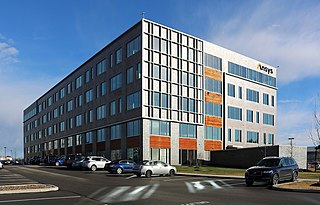
An engine or motor is a machine designed to convert one or more forms of energy into mechanical energy.
CHEMKIN is a proprietary software tool for solving complex chemical kinetics problems. It is used worldwide in the combustion, chemical processing, microelectronics and automotive industries, and also in atmospheric science. It was originally developed at Sandia National Laboratories and is now developed by a US company, Reaction Design.

Ansys, Inc. is an American multinational company with its headquarters based in Canonsburg, Pennsylvania. It develops and markets CAE/multiphysics engineering simulation software for product design, testing and operation and offers its products and services to customers worldwide.
Homogeneous Charge Compression Ignition (HCCI) is a form of internal combustion in which well-mixed fuel and oxidizer are compressed to the point of auto-ignition. As in other forms of combustion, this exothermic reaction produces heat that can be transformed into work in a heat engine.
COSILAB is a software tool for solving complex chemical kinetics problems. It is used worldwide in research and industry, in particular in automotive, combustion, and chemical processing applications.
This is an alphabetical list of articles pertaining specifically to chemical engineering.

Tecplot is the name of a family of visualization & analysis software tools developed by American company Tecplot, Inc., which is headquartered in Bellevue, Washington. The firm was formerly operated as Amtec Engineering. In 2016, the firm was acquired by Vela Software, an operating group of Constellation Software, Inc. (TSX:CSU).

Airflow Sciences Corporation (ASC) is an engineering consulting company based in Livonia, Michigan, USA that specializes in the design and optimization of equipment and processes involving flow, heat transfer, combustion, and mass transfer. Engineering techniques include Computational Fluid Dynamics (CFD) modeling, experimental laboratory testing, and field measurements at client sites. ASC works for a wide range of industries world-wide, including power generation, manufacturing, aerospace, HVAC, food processing, biomedical, pollution control, oil and gas, rail, legal, and automotive.
The Kinetic PreProcessor (KPP) is an open-source software tool used in atmospheric chemistry. Taking a set of chemical reactions and their rate coefficients as input, KPP generates Fortran 90, FORTRAN 77, C, or Matlab code of the resulting ordinary differential equations (ODEs). Solving the ODEs allows the temporal integration of the kinetic system. Efficiency is obtained by exploiting the sparsity structures of the Jacobian and of the Hessian. A comprehensive suite of stiff numerical integrators is also provided. Moreover, KPP can be used to generate the tangent linear model, as well as the continuous and discrete adjoint models of the chemical system.
Khimera is a software product from Kintech Lab intended for calculation of the kinetic parameters of microscopic processes, thermodynamic and transport properties of substances and their mixtures in gases, plasmas and also of heterogeneous processes. The development of a kinetic mechanism is a key stage of present-day technologies for the creation of hi-tech devices and processes in a wide range of fields, such as microelectronics, chemical industry, and the design and optimization of combustion engines and power stations. Khimera with Chemical WorkBench, another software product from Kintech Lab, allows both the development of complex physical and chemical mechanisms and their validation. Essential feature of Khimera is its user-friendly interface for importing and utilizing the results of quantum-chemical calculations for estimating rate constants of elementary processes and thermodynamic and transport properties.
Chemical WorkBench is a proprietary simulation software tool aimed at the reactor scale kinetic modeling of homogeneous gas-phase and heterogeneous processes and kinetic mechanism development. It can be effectively used for the modeling, optimization, and design of a wide range of industrially and environmentally important chemistry-loaded processes. Chemical WorkBench is a modeling environment based on advanced scientific approaches, complementary databases, and accurate solution methods. Chemical WorkBench is developed and distributed by Kintech Lab.

KIVA is a family of Fortran-based computational fluid dynamics software developed by Los Alamos National Laboratory (LANL). The software predicts complex fuel and air flows as well as ignition, combustion, and pollutant-formation processes in engines. The KIVA models have been used to understand combustion chemistry processes, such as auto-ignition of fuels, and to optimize diesel engines for high efficiency and low emissions. General Motors has used KIVA in the development of direct-injection, stratified charge gasoline engines as well as the fast burn, homogeneous-charge gasoline engine. Cummins reduced development time and cost by 10%–15% using KIVA to develop its high-efficiency 2007 ISB 6.7-L diesel engine that was able to meet 2010 emission standards in 2007. At the same time, the company realized a more robust design and improved fuel economy while meeting all environmental and customer constraints.
Combustion models for CFD refers to combustion models for computational fluid dynamics. Combustion is defined as a chemical reaction in which a hydrocarbon fuel reacts with an oxidant to form products, accompanied with the release of energy in the form of heat. Being the integral part of various engineering applications like: internal combustion engines, aircraft engines, rocket engines, furnaces, and power station combustors, combustion manifests itself as a wide domain during the design, analysis and performance characteristics stages of the above-mentioned applications. With the added complexity of chemical kinetics and achieving reacting flow mixture environment, proper modeling physics has to be incorporated during computational fluid dynamic (CFD) simulations of combustion. Hence the following discussion presents a general outline of the various adequate models incorporated with the Computational fluid dynamic code to model the process of combustion.
The SRM Engine Suite is an engineering software tool used for simulating fuels, combustion and exhaust gas emissions in internal combustion engine applications. It is used worldwide by leading IC engine development organisations and fuel companies. The software is developed, maintained and supported by CMCL Innovations, Cambridge, U.K.
Chemical reaction models transform physical knowledge into a mathematical formulation that can be utilized in computational simulation of practical problems in chemical engineering. Computer simulation provides the flexibility to study chemical processes under a wide range of conditions. Modeling of a chemical reaction involves solving conservation equations describing convection, diffusion, and reaction source for each component species.

Convergent Science is an engineering software company which has its headquarters in Madison, Wisconsin. The company develops and supports CONVERGE CFD software, a general purpose computational fluid dynamics (CFD) solver.
Jacqueline H. Chen is an American mechanical engineer. She works in the Combustion Research Facility of Sandia National Laboratories, where she is a Senior Scientist. Her research applies massively parallel computing to the simulation of turbulent combustion.

Guy B. Marin is professor emeritus of chemical engineering at the Ghent University, Belgium. He is founding member of the Laboratory for Chemical Technology (LCT) and the Center of Sustainable Chemistry (CSC) at Ghent University. Prior to that, he has been teaching at the Department of Chemical Engineering and Chemistry of Eindhoven University of Technology. His research on chemical kinetics and chemical reaction engineering led in 2015 to a spinoff company. He co-authored two books, Kinetics of Chemical Reactions: Decoding Complexity and Advanced Data Analysis and Modelling in Chemical Engineering.

Peter Kelly Senecal is a mechanical engineer, academic and author. He is a co-founder and Owner of Convergent Science and one of the original developers of CONVERGE, a computational fluid dynamics software. Additionally, he holds positions as a visiting professor at the University of Oxford, an adjunct professor at the University of Wisconsin–Madison, and a co-founder and Director of the Computational Chemistry Consortium (C3).








